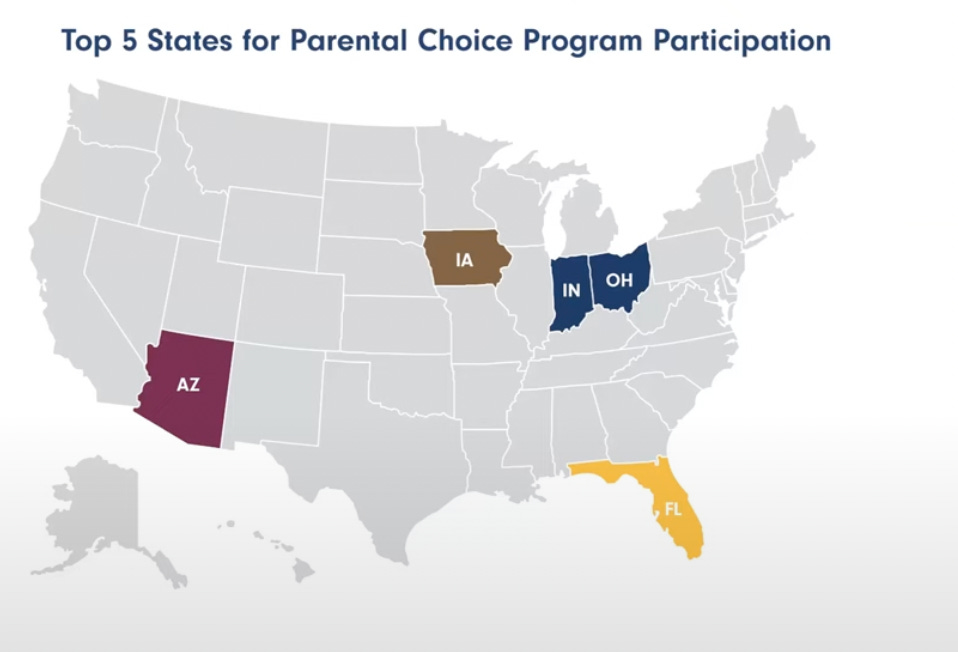Twenty states last year expanded their parental school choice programs, which allow parents to use some public education money to fund the enrollment of their children in private schools, including Catholic schools.
The National Catholic Education Association advocated in the recently released 2023-2024 school year Data Brief that “Catholic schools should advocate for the expansion of these programs, enhance awareness among families and tailor their educational offerings to attract and retain students benefiting from school choice, ensuring access to Catholic education for a broader demographic.”
But are the expansion of parental choice programs affecting trends in Catholic school education?
The Pillar looks at the numbers.
The percentage of Catholics in the U.S. population has been relatively stable over the last 50 years, declining from 24% in 1970 to 20% in 2022.
But during that same period, the percentage of American K-12 students attending Catholic schools has dropped by two-thirds, from 9% to 3%.
As with other aspects of participation in Catholic life in the US, there are many reasons for that decline. But among them is a shift in staffing, which drove up the cost of Catholic schools.
When Catholic schools were initially built in the U.S. during the 1800s, schools were staffed primarily by members of religious orders. That staffing allowed schools to charge very low tuition, making them widely affordable for Catholic families, including working class immigrants.
That structure continued into the 20th century.
In the Diocese of Cleveland, Catholic elementary school tuition in 1971 averaged $100 per year. Adjusted for inflation, that is $771 in 2024 dollars.
With a collapse of vocations in many religious orders in the U.S. after Vatican II, it became in the late 20th century necessary for Catholic schools to employ primarily lay teachers.
Pay for teachers in Catholic schools is often significantly lower than for teachers in public schools, but the aim of paying a living wage to teachers has raised tuition significantly in most places.
A survey of tuition rates listed on local Catholic elementary school websites in Ohio today showed annual tuition rates in the low $6,000 range, more than 6 times the inflation-adjusted 1970s rate in the Cleveland diocese.
Public schools do not charge tuition, because they are paid for with tax revenues, but the spending per student in public schools is often significantly higher than Catholic school tuition.
According to a U.S. Census survey of school system finances, the average spending per student across public school systems in 41 states was $16,000 per student in the 2021-2022 fiscal year — Idaho had the lowest spending of the reporting states at $9,670 while New York had the highest at $27,504.
The disparity has placed Catholic schools in a difficult position, as they balance affordability and costs.
Models of Catholic school funding vary widely across the country. Some schools rely heavily on parish contributions to supplement tuition. Others rely on fundraising. On its own, tuition rarely covers a school’s actual cost-per-pupil. But tuition is still a stretch for many families. Raising tuition to allow Catholic schools to compete on salaries with public schools would likely price out many Catholic school families; a correspondent decline in enrollment would make budgets even tighter.
But Catholic schools do not face those challenges in all countries. In neighboring Canada, Catholic schools receive government funding for the number of students they teach, just as secular schools, and schools of other faiths do.
Nor have U.S. schools always been strictly secular. But during the second half of the 1800s, prejudice against Catholic immigrants led to the passage of so-called “Blaine amendments” in many states. Named after an amendment to the U.S. Constitution proposed by congressman James G. Blaine — which passed the U.S. House of Representatives but failed to gather sufficient votes for passage in the Senate in 1875 — the Blaine amendments banned the use of government funds to pay for schools “under the control of any religious sect.”
At that time, it was considered normal, and Constitutional, for public schools to include Bible reading, prayer, and instruction in Protestant religious doctrine, and Blaine amendments did not change this. Their passage was only interpreted to ban government funds going to schools run by a specific religious “sect” such as the Catholic Church.
Although the federal Blaine amendment failed, all but 12 states passed their own state Blaine amendments. Until recently that meant Catholic schools in the U.S. received no government funding. — parents with children in Catholic schools paid the state and local taxes which funded public schools, and then paid their own children’s tuition.
But beginning with the Milwaukee Parental Choice Program enacted in 1990, some states and localities have begun to institute programs by which parents can receive a portion of the taxpayer funds which would have paid for their children to attend public schools, and use those funds instead to help pay for tuition at the private school of their choice.
With recent expansions of parental choice programs, Catholic schools across the country have begun to see a significant increase in the number of students receiving government funds.
According to data collected by the NCEA, the number of students in Catholic schools receiving parental choice funding has doubled in the last two years from 6.8% in the 2021-2022 school year to 13.7% in the 2023-2034 school year.
The states with the highest rates of parental choice funding for Catholic schools are Ohio, Florida, Indiana, and Arizona. All dioceses in those states reported to the NCEA that in the 2023-2024 school year, more than 50% of Catholic school students were receiving parental choice funds.
In Ohio, the EdChoice program was expanded by the legislature in 2023. It now provides scholarships of $6,166 for students in grades K-8 and $8,408 to students in high school, so long as their family incomes are at or below 450% of the federal poverty level — for a family of four, 450% of the federal poverty level is $135,000/yr.
Ohio families with higher incomes receive a lower amount based on a sliding scale defined by the state.
Florida’s Step Up For Students program offers scholarships averaging $7,800 per student to allow families to enroll their children in a private school of their choice. Priority is given to families with incomes below 400% of the federal poverty level, but all families are eligible to receive funds.
The Indiana Choice Scholarship Program is available to Indiana families with incomes below 400% of the amount necessary to qualify for the federal school lunch program. For a family of four, this means an income of $230,880 in the coming school year.
Indiana scholarship awards vary between $6000 and $7000 according to school district.
Arizona’s parental choice program offers Empowerment Scholarship Accounts to all students who would be eligible to enroll in Arizona public schools. Those accounts can be used to pay for educational expenses, including private school tuition.
In the 2022-2023 school year, the average Arizona scholarship award was $6,966, though amounts varied significantly based on grade level and also on special needs, with students with disabilities receiving substantially more.
Parental choice programs are having an effect on levels of enrollment in Catholic schools. In the NCEAs list of Catholic dioceses with the largest school enrollments, four dioceses in those states had seen virtually flat enrollment over the last five years, with a decrease in enrollment of 1%. By comparison Catholic school enrollment in the other 16 largest enrollment dioceses had decreased by 7%.
It remains to be seen whether increasing parental choice programs will reverse the long term enrollment decline in Catholic schools, in the places where funding is available to put tuition more within reach of the average Catholic family.
Catholic schools also face significant questions on their curriculums and intellectual identity.
But initial signs suggest that such programs may provide a way forward for Catholic schools struggling to find a financial path since the loss of the large education-focused religious orders in the wake of Vatican II.





